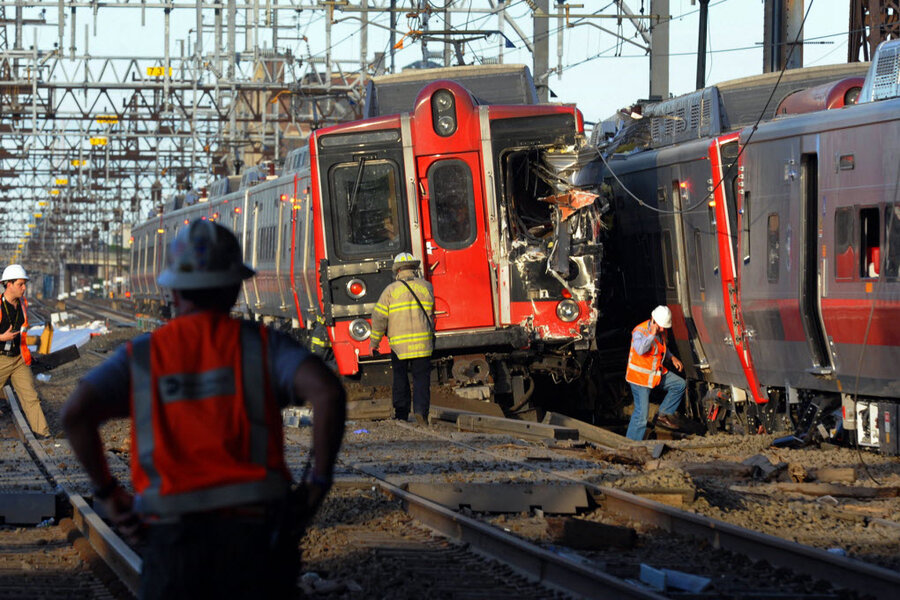Investigation begins after Connecticut commuter trains collide
Loading...
| Fairfield, Conn.
Two commuter trains packed with rush-hour commuters collided in an accident that sent about 70 people to the hospital, severely damaged the tracks and threatened to snarl travel in the congested Northeast Corridor.
Three patients remained in critical condition Saturday morning, with two of those stable, according to officials at two Bridgeport hospitals.
The crash happened Friday evening on the Metro-North Railroad, which serves the northern suburbs of New York City.
Passengers described a chaotic, terrifying scene of crunching metal and flying bodies.
"All I know was I was in the air, hitting seats, bouncing around, flying down the aisle and finally I came to a stop on one seat," Lola Oliver, 49, of Bridgeport, told The Associated Press. "It happened so fast I had no idea what was going on. All I know is we crashed."
About 700 people were on board the Metro-North trains when one heading east from New York City's Grand Central Station to New Haven derailed about 6:10 p.m. just outside Bridgeport, MTA and Bridgeport officials said.
The train was hit by a train heading west from New Haven to Grand Central on an adjacent track, MTA spokesman Aaron Donovan said. Some cars on the second train also derailed as a result of the collision.
"We're most concerned about the injured and ultimately reopening the system," Connecticut Gov. Dannel P. Malloy said from the scene about three hours after the crash.
The governor said that most people were not seriously hurt. Among those critically injured, he said, one's injuries were "very critical."
The nursing supervisor at St. Vincent Medical Center said Saturday morning that 44 people from the crash had been treated there, and that five of those were admitted. One of the five remained in critical condition but was now stable, the supervisor said.
Bridgeport Hospital spokesman John Cappiello said two patients were admitted in critical condition, and one of those was now stable. The hospital treated 24 other patients from the crash, and many had been released already with the rest expected to be released by late Saturday morning, Cappiello said.
The Metro-North Railroad, a commuter line serving the northern suburbs, described it as a "major derailment." Photos showed a train car askew on the rails, with its end smashed up and brushing against another train.
Malloy said there was extensive damage to the train cars and the track, and it could take until Monday for normal service to be restored. He said the accident will have a "big impact on the Northeast Corridor."
Amtrak, which uses the same rails, suspended service indefinitely between New York and Boston.
Bridgeport Mayor Bill Finch said the disruption caused by the train accident could cost the region's economy millions of dollars.
"A lot of people rely on this, and we've got to get this reconnected as soon as possible," Finch said.
Investigators Friday night did not know what caused the first train to derail. Malloy said there was no reason to believe it was anything other than an accident. The National Transportation Safety Board was sending a team to investigate.
Passenger Bradley Agar of Westport, Conn., said he was in the first car of the westbound train when he heard screaming and the window smash behind him.
"I saw the first hit, the bump, bump, bump all the way down," he said.
Agar had returned to work this week for the first time since breaking his shoulder in January. And since he was still healing, he thought it would be safer to take the train than drive.
The area where the accident happened was already down to two tracks because of repair work, Malloy said. Crews have been working for a long time on the electric lines above the tracks, the power source for the trains. He said Connecticut has an old system and no other alternate tracks.
By late evening, Bridgeport Police Chief Joseph Gaudett said everybody who needed treatment had been attended to, and authorities were beginning to turn their attention to investigating the cause.
"Everybody seemed pretty calm," he said. "Everybody was thankful they didn't get seriously hurt. They were anxious to get home to their families."
The Metropolitan Transportation Authority operates the Metro-North Railroad, the second-largest commuter railroad in the nation. The Metro-North main lines — the Hudson, Harlem, and New Haven — run northward from New York City's Grand Central Terminal into suburban New York and Connecticut.
Associated Press writer Michael Melia contributed to this report from Hartford, Conn.







